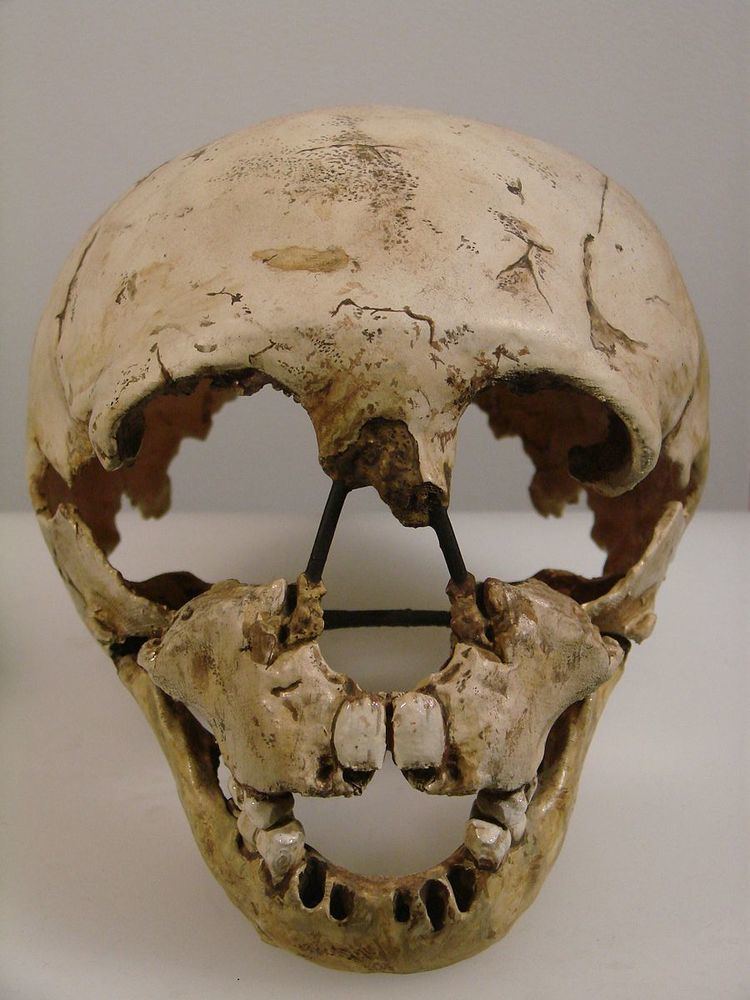Date discovered 1926 | Species Homo neanderthalensis | |
 | ||
Place discovered | ||
Gibraltar 2, also known as Devil's Tower Child, represented five skull fragments of a female Neanderthal child discovered in the British Overseas Territory of Gibraltar. The discovery of the fossils at the Devil's Tower Mousterian rock shelter was made by archaeologist Dorothy Garrod in 1926. It represented the second excavation of a Neanderthal skull in Gibraltar, after Gibraltar 1, the second Neanderthal skull ever found (after Engis 2). In the early twenty-first century, Gibraltar 2 underwent reconstruction. Continued excavation in Gibraltar, combined with radiocarbon dating of charcoal from Gorham's Cave in 2006, has led to the conclusion that the caves may have represented the last refuge of the last surviving Neanderthals.
Contents
History of Gibraltar 1
Prehistoric man resided in Gibraltar, the British Overseas Territory at the southern end of the Iberian Peninsula. The evidence was first found in the Devil's Tower Road area, at Forbes' Quarry, in the north face of the Rock of Gibraltar. This was the site of the 1848 discovery of the first Neanderthal skull by Lieutenant Edmund Flint (d. 12 January 1857) of the Royal Artillery. The fossil, an adult female skull, is referred to as Gibraltar 1 or the Gibraltar Skull (pictured at left). Neanderthals were unknown at the time that the fossil was found. Lieutenant Flint, secretary of the Gibraltar Scientific Society, presented his discovery to the organisation on 3 March 1848. Eight years later, in 1856, fossils were discovered in a cave of the Neander Valley near Düsseldorf, Germany. Those remains were described in 1864 as Homo neanderthalensis by Professor W. King of Queen's College, Galway, now University College. Later that year, the Gibraltar Skull was sent to England and exhibited by George Busk at the meeting of the British Association for the Advancement of Science, with its similarity to the Neander Valley fossils noted. However, it wasn't until the early twentieth century that it was realized that Gibraltar 1 was the skull of a Neanderthal. If the skull's significance had been understood in the nineteenth century, Neanderthal Man would probably have been termed "Gibraltar Man".
Discovery of Gibraltar 2
Additional evidence of Neanderthal occupation in Gibraltar was found at the Devil's Tower Mousterian rock shelter, also at the north face of the Rock of Gibraltar. Devil's Tower was a seventeenth century watchtower which was located at the eastern end of Devil's Tower Road. The archaeological site was initially discovered by Abbé Henri Édouard Prosper Breuil (1877 – 1961), who had recommended investigation. Breuil, a French paleontologist and archaeologist, is renowned for his expertise on prehistoric cave art.
The excavations at the Devil's Tower cave commenced in November 1925 and continued until December 1926, and were performed in three phases. In 1926, the skull of a Neanderthal child was discovered by archaeologist Dorothy Garrod. Garrod, who had studied with Breuil in Paris, went on to perform archaeological excavations in France, Palestine, Kurdistan, and Bulgaria. She had the distinction of being the first female professor at both the University of Cambridge and the University of Oxford. In addition, in 1939, Garrod was elected to the Disney Chair. Garrod found five skull fragments which were described by the archaeologist and others in The Journal of the Royal Anthropological Institute of Great Britain and Ireland in 1928. The five fragments were maxillary, parietal, temporal, cranial, and mandibular. Flaked stone tools were discovered near the child's remains and were indicative of Mousterian industry. The skull of the female Neanderthal child is known as Gibraltar 2 or Devil's Tower Child (pictured above).
In a study described in 1993 in the Journal of Human Evolution, the striation pattern of the dental enamel of the Devil's Tower Child fossil was compared to that of modern hunter-gatherers and medieval individuals from Spain. It was found that the Devil's Tower Child had a more abrasive diet than medieval individuals. Gibraltar 2 had a high number of striations. Further, the ratio of horizontal to vertical striations suggested that Gibraltar 2 may have been primarily carnivorous. The child is estimated to have been about four years old at the time of death.
By 2008, the face of the Devil's Tower Child had been reconstructed (pictured below) at the University of Zurich by means of computer-assisted paleoanthropology (CAP). This involved using computed tomography (CT) to perform volume data acquisition of the five skull fragments unearthed by Garrod in 1926. The five cranial fragments were then transformed with the software FoRM-IT into virtual 3D images. With the five virtual images then suspended in anatomical space according to scientific criteria, the missing fragments were replaced with mirror images of the excavated fragments. By means of laser stereolithography, the virtual reconstruction of the face and skull of the Devil's Tower Child was converted to a physical model. The soft tissues were then approximated using 3D Thin Plate Splining (TPS) with data from a modern child. Plasticine modelling clay was accordingly applied on the physical model to simulate soft tissue. The final model of Gibraltar 2 was then cast; finishing touches included paint and human hair (link to final image below).
Gibraltar as refugium
Until the late twentieth century, it was believed that the last Neanderthals disappeared about 35,000 years ago. However, studies have suggested that Neanderthals survived in southern Spain and Gibraltar to less than 30,000 years before the present. Radiocarbon dating performed on charcoal in Gorham's Cave in Gibraltar in 2006 suggests that Neanderthals lived there 24,000 to 28,000 years ago, well after the arrival of Homo sapiens in Europe 40,000 years ago. Vanguard Cave and Gorham's Cave are still the sites of active archaeological excavation in 2012. Gibraltar may have represented the refugium of the Neanderthals.
